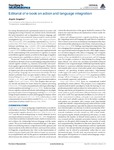Editorial of E-Book on Action and Language Integration
| dc.contributor.author | Cangelosi, Angelo | |
| dc.date.accessioned | 2015-10-13T19:03:07Z | |
| dc.date.available | 2015-10-13T19:03:07Z | |
| dc.date.issued | 2012 | |
| dc.identifier.issn | 1662-5218 | |
| dc.identifier.issn | 1662-5218 | |
| dc.identifier.uri | http://hdl.handle.net/10026.1/3612 | |
| dc.description.abstract |
Increasing theoretical and experimental research on action and language processing in humans and animals clearly demonstrates the strict interaction and co-dependence between language and action. This has been extensively demonstrated in neuroscientific investigations (e.g., Rizzolatti and Arbib, 1998; Cappa and Perani, 2003; Pulvermuller, 2003), psychology experiments (e.g., Glenberg and Kaschak, 2002; Pecher and Zwaan, 2005; Barsalou, 2008), evolutionary psychology (e.g., Corballis, 2002), and computational modeling (e.g., Cangelosi and Parisi, 2004; Massera et al., 2007; Cangelosi, 2010). All these studies have important implication both for the understanding of the action basis of cognition in natural and artificial cognitive systems, as well as for the design of cognitive and communicative capabilities in robots (Cangelosi et al., 2010). The journal “Frontiers in Neurorobotics” published a collection of articles on the topic of action and language integration both in natural cognitive systems (e.g., humans and animals) and in artificial cognitive agents (robots and simulated agents). These articles are now collected in an e-book, for wider dissemination. This set of chapters provides an up to date overview of current advances in the grounding of language into sensorimotor knowledge. The first chapters primarily focus on experimental evidence from cognitive psychology (Symes et al., 2010), cognitive neuroscience studies (Borghi et al., 2010), and comparative experimental/simulation studies (Greco and Caneva, 2010). Two chapters then use neural network simulation for motor chains for sentence processing (Chersi et al., 2010) and a computational model of gaze planning in word recognition and reading (Ferro et al., 2010). Finally, four chapters use cognitive systems and robotics methodologies to investigate general principles of action–language grounding (Parisi, 2010), teleological representations of action and language for human–robot interaction experiments (Lallee et al., 2010), verbal and non-verbal communication in neurorobotics models (Bicho et al., 2010), and action bases of action words (Marocco et al., 2010). | |
| dc.format.extent | 2- | |
| dc.format.medium | Electronic-eCollection | |
| dc.language | eng | |
| dc.language.iso | eng | |
| dc.publisher | Frontiers Media SA | |
| dc.title | Editorial of E-Book on Action and Language Integration | |
| dc.type | journal-article | |
| dc.type | Journal Article | |
| plymouth.author-url | https://www.ncbi.nlm.nih.gov/pubmed/22557966 | |
| plymouth.issue | MAY | |
| plymouth.volume | 6 | |
| plymouth.publication-status | Published online | |
| plymouth.journal | Frontiers in Neurorobotics | |
| dc.identifier.doi | 10.3389/fnbot.2012.00002 | |
| plymouth.organisational-group | /Plymouth | |
| plymouth.organisational-group | /Plymouth/Faculty of Science and Engineering | |
| plymouth.organisational-group | /Plymouth/Faculty of Science and Engineering/School of Engineering, Computing and Mathematics | |
| plymouth.organisational-group | /Plymouth/Research Groups | |
| plymouth.organisational-group | /Plymouth/Research Groups/Institute of Health and Community | |
| plymouth.organisational-group | /Plymouth/Research Groups/Marine Institute | |
| dc.publisher.place | Switzerland | |
| dcterms.dateAccepted | 2012-01-01 | |
| dc.rights.embargodate | 2023-10-3 | |
| dc.identifier.eissn | 1662-5218 | |
| dc.rights.embargoperiod | Not known | |
| rioxxterms.versionofrecord | 10.3389/fnbot.2012.00002 | |
| rioxxterms.licenseref.uri | http://www.rioxx.net/licenses/all-rights-reserved | |
| rioxxterms.licenseref.startdate | 2012 | |
| rioxxterms.type | Journal Article/Review |


